Colin McCrate's Blog, page 10
July 1, 2018
Episode 92: Hand Pollinating Winter Squash

This week on the podcast Hilary and Stephen Mirsky, of Seed Savers Exchange, discuss how to increase your winter squash yields through hand pollination.
HOW TO LISTEN:Subscribe in iTunes , Stitcher, or any of your favorite podcast players to have new episodes sent directly to your device.
Listen right now in your browser by clicking above.
Like what you hear? Please share our podcast with a friend. Subscribe on iTunes or your favorite podcast player so you never miss a beat. And we'd really appreciate you showing us some love by leaving a rating and review on iTunes.
Have a topic you'd like see us dig in to? Leave us a note in the comment section below or #EBpodcast on Instagram and Twitter!
Your support is what keeps this podcast going! Any amount helps, so consider support us by making a one-time contribution:
Make a one time contribution

photo by charity burrgraaf
More about this weeks guest expert:
Steffen Mirsky, Assistant Curator at Seed Savers Exchange, manages the Evaluation and Citizen Science Corps programs. Since 2011, he has helped document about 5000 varieties of fruits and vegetables in the Seed Savers Exchange collection, some of which have been introduced into the Seed Savers Exchange catalog. He was a contributor to Seed Savers Exchange’s award winning book The Seed Garden and the 2015 Nursery Trade Census, and regularly writes for the annual Seed Savers Exchange Yearbook, quarterly Heritage Farm Companion, and Seed Savers Exchange blog.
In addition, Steffen is founder and co-owner of Twin Springs Farm, a one acre seed and direct market vegetable farm on the edge of Decorah, Iowa.
Website: https://www.seedsavers.org/
Instagram: @twin_springs_farm

About the Host:
Hello, I’m Hilary Dahl. Outside of this podcast, my job is to help beginning and experienced growers create beautiful and productive gardens. I have the unique experience of working in on a wide range of projects, from small backyard garden plots to multi-acre vegetable farms. I also work in my own garden every day when I get home. This podcast is an opportunity to discuss seasonal garden topics and share the the joy of growing your own food.
Encyclopedia Botanica Podcast, Episode 92: Hand Pollinating Winter Squash

This week on the podcast Hilary and Stephen Mirsky, of Seed Savers Exchange, discuss how to increase your winter squash yields through hand pollination.
HOW TO LISTEN:Subscribe in iTunes , Stitcher, or any of your favorite podcast players to have new episodes sent directly to your device.Listen right now in your browser by clicking above.Like what you hear? Please share our podcast with a friend. Subscribe on iTunes or your favorite podcast player so you never miss a beat. And we'd really appreciate you showing us some love by leaving a rating and review on iTunes.
Have a topic you'd like see us dig in to? Leave us a note in the comment section below or #EBpodcast on Instagram and Twitter!
We need your support to keep this podcast going! Any amount helps, so consider support us one of two ways:
Become an Encyclopedia Botanica Patreon
OR
Make a One-Time Contribution

photo by charity burrgraaf
More about this weeks guest expert:
Steffen Mirsky, Assistant Curator at Seed Savers Exchange, manages the Evaluation and Citizen Science Corps programs. Since 2011, he has helped document about 5000 varieties of fruits and vegetables in the Seed Savers Exchange collection, some of which have been introduced into the Seed Savers Exchange catalog. He was a contributor to Seed Savers Exchange’s award winning book The Seed Garden and the 2015 Nursery Trade Census, and regularly writes for the annual Seed Savers Exchange Yearbook, quarterly Heritage Farm Companion, and Seed Savers Exchange blog.
In addition, Steffen is founder and co-owner of Twin Springs Farm, a one acre seed and direct market vegetable farm on the edge of Decorah, Iowa.
Website: https://www.seedsavers.org/
Instagram: @twin_springs_farm

About the Host:
Hello, I’m Hilary Dahl. Outside of this podcast, my job is to help beginning and experienced growers create beautiful and productive gardens. I have the unique experience of working in on a wide range of projects, from small backyard garden plots to multi-acre vegetable farms. I also work in my own garden every day when I get home. This podcast is an opportunity to discuss seasonal garden topics and share the the joy of growing your own food.
June 15, 2018
Episode 91: Basil
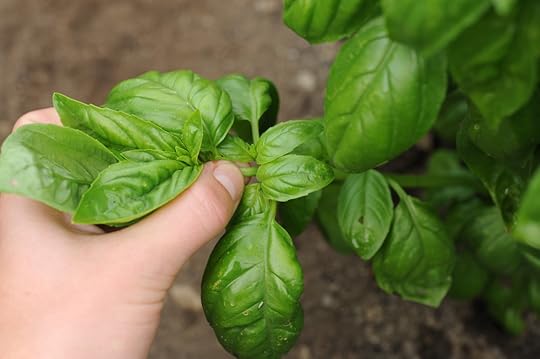
Basil is one of those crops that almost everyone wants to grow. It's relatively versatile and it is one of the most productive crops per plant that you can grow in your garden. In this episode Hilary is joined by former Seattle Urban Farm Co. colleague and farmer, Skip Mackintosh to discuss their time-tested techniques for making the most of the space you've dedicated to basil.
HOW TO LISTEN:Subscribe in iTunes , Stitcher, or any of your favorite podcast players to have new episodes sent directly to your device.
Listen right now in your browser by clicking above.
SHOW NOTES:Basil needs pretty warm conditions and a ton of light to get started, I would not recommend trying to propagate this crop at home unless you are a relatively experienced nursery grower. It is definitely not the easiest crop to start out with in the home nursery.
Wait to plant basil until temperatures are consistently above 50 degrees F, including at night!
Cold damage on basil comes in a few forms: often you will notice gold or brown colored spots on the leaves, which then after being damaged in this way will begin to rot. If you have otherwise healthy plants, keep an eye out for discoloration like this and remove the affected parts if you can. Cold nights can also lead to stem rot and fungal growth on the stems of the plant. A common site in spring or late in the fall is a basil plant with dark coloration on the stems which quickly leads to grey mold and usually a dead or severly damaged plant. In Seattle, we don’t plant basil outside in the garden until June, which seems really late in the spring, but Basil grows very quickly, so it is possible to get in a great harvest even if you get a late start.
One key to success with delicate crops like this is the willingness to replant if plants get damaged by cold weather or pests.
Regular harvesting is key to a productive basil plant! I recommend using a pair of scissors to snip back the top of each stalk on your basil plant. What you'll notice is that, if you snip back the stem just above a leaf node, the stem will branch out from both sides of the node, producing two stems from one (see top photo!).
Left to right: Flowering basil and trimming basil
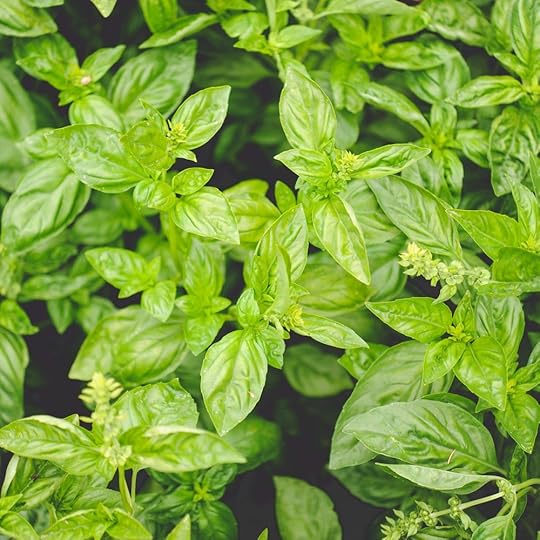
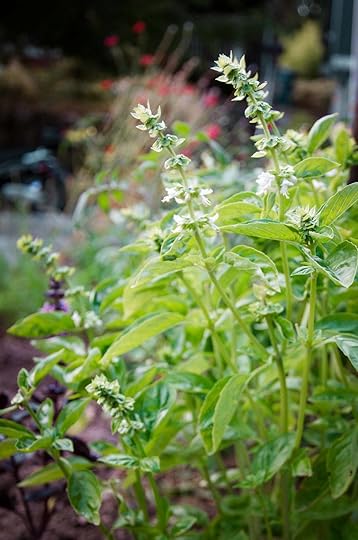

Like what you hear? Please share our podcast with a friend. Subscribe on iTunes or your favorite podcast player so you never miss a beat. And we'd really appreciate you showing us some love by leaving a rating and review on iTunes.
Have a topic you'd like see us dig in to? Leave us a note in the comment section below or #EBpodcast on Instagram and Twitter!
Your support is what keeps this podcast going! Any amount helps, so consider support us by making a one-time contribution:
Make a one time contribution
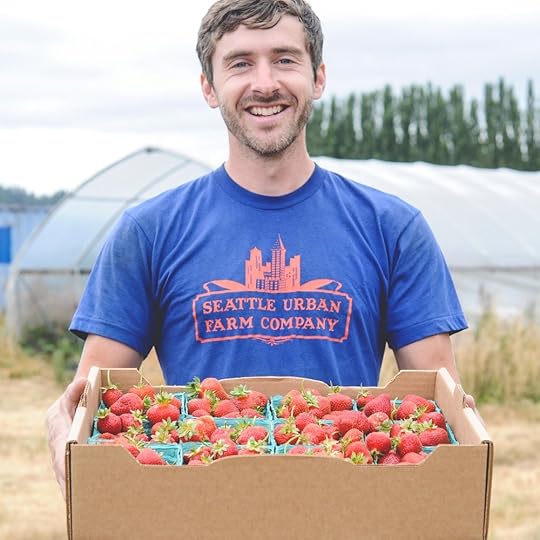
photo by charity burrgraaf
More about this weeks guest expert:
Skip worked at Seattle Urban Farm Co for over 4 years. Skip spent his first few years at SUFCo installing edible gardens, and later moved on to managing our 4-acre restaurant farm outside of Seattle. Before working with SUFCo he worked at Let Us Farm, a farm located in Oakville, WA that specialized in lettuce and basil.

About the Host:
Hello, I’m Hilary Dahl. Outside of this podcast, my job is to help beginning and experienced growers create beautiful and productive gardens. I have the unique experience of working in on a wide range of projects, from small backyard garden plots to multi-acre vegetable farms. I also work in my own garden every day when I get home. This podcast is an opportunity to discuss seasonal garden topics and share the the joy of growing your own food.
Encyclopedia Botanica Podcast, Episode 91: Basil

Basil is one of those crops that almost everyone wants to grow. It's relatively versatile and it is one of the most productive crops per plant that you can grow in your garden. In this episode Hilary is joined by former Seattle Urban Farm Co. colleague and farmer, Skip Mackintosh to discuss their time-tested techniques for making the most of the space you've dedicated to basil.
HOW TO LISTEN:Subscribe in iTunes , Stitcher, or any of your favorite podcast players to have new episodes sent directly to your device.Listen right now in your browser by clicking above.SHOW NOTES:Basil needs pretty warm conditions and a ton of light to get started, I would not recommend trying to propagate this crop at home unless you are a relatively experienced nursery grower. It is definitely not the easiest crop to start out with in the home nursery.Wait to plant basil until temperatures are consistently above 50 degrees F, including at night!Cold damage on basil comes in a few forms: often you will notice gold or brown colored spots on the leaves, which then after being damaged in this way will begin to rot. If you have otherwise healthy plants, keep an eye out for discoloration like this and remove the affected parts if you can. Cold nights can also lead to stem rot and fungal growth on the stems of the plant. A common site in spring or late in the fall is a basil plant with dark coloration on the stems which quickly leads to grey mold and usually a dead or severly damaged plant. In Seattle, we don’t plant basil outside in the garden until June, which seems really late in the spring, but Basil grows very quickly, so it is possible to get in a great harvest even if you get a late start.One key to success with delicate crops like this is the willingness to replant if plants get damaged by cold weather or pests. Regular harvesting is key to a productive basil plant! I recommend using a pair of scissors to snip back the top of each stalk on your basil plant. What you'll notice is that, if you snip back the stem just above a leaf node, the stem will branch out from both sides of the node, producing two stems from one (see top photo!).Left to right: Flowering basil and trimming basil



Like what you hear? Please share our podcast with a friend. Subscribe on iTunes or your favorite podcast player so you never miss a beat. And we'd really appreciate you showing us some love by leaving a rating and review on iTunes.
Have a topic you'd like see us dig in to? Leave us a note in the comment section below or #EBpodcast on Instagram and Twitter!
We need your support to keep this podcast going! Any amount helps, so consider support us one of two ways:
Become an Encyclopedia Botanica Patreon
OR
Make a One-Time Contribution

photo by charity burrgraaf
More about this weeks guest expert:
Skip worked at Seattle Urban Farm Co for over 4 years. Skip spent his first few years at SUFCo installing edible gardens, and later moved on to managing our 4-acre restaurant farm outside of Seattle. Before working with SUFCo he worked at Let Us Farm, a farm located in Oakville, WA that specialized in lettuce and basil.

About the Host:
Hello, I’m Hilary Dahl. Outside of this podcast, my job is to help beginning and experienced growers create beautiful and productive gardens. I have the unique experience of working in on a wide range of projects, from small backyard garden plots to multi-acre vegetable farms. I also work in my own garden every day when I get home. This podcast is an opportunity to discuss seasonal garden topics and share the the joy of growing your own food.
June 1, 2018
Episode 90: Intuitive Cooking with Shannon Douglas, Spring Crop Edition

Shannon Douglas of Honest Magazine defines "cooking intuitively" is a style of cooking based on understanding the fundamentals of cooking and paying close attention to your ingredients. In this episode she joins Hilary to discuss some general garden-inspired cooking tips that you can apply to a variety of crops. They'll focus on 2 spring crops, peas and radishes, to help illustrate these points. As always, Hilary will sprinkle in her harvesting and gardening tips as they relate to cooking intuitively.
HOW TO LISTEN:Subscribe in iTunes , Stitcher, or any of your favorite podcast players to have new episodes sent directly to your device.
Listen right now in your browser by clicking above.
REsources Mentioned in this episode:
Six Seasons: A New Way with Vegetables
By Joshua McFadden

Salt, Fat, Acid, Heat: Mastering the Elements of Good Cooking
By Samin Nosrat
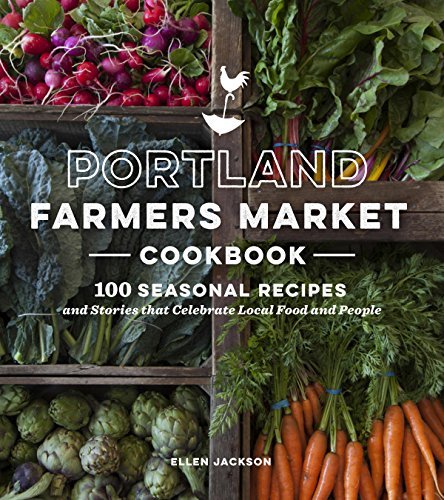
Portland Farmers Market Cookbook: 100 Seasonal Recipes and Stories that Celebrate Local Food and People
By Ellen Jackson
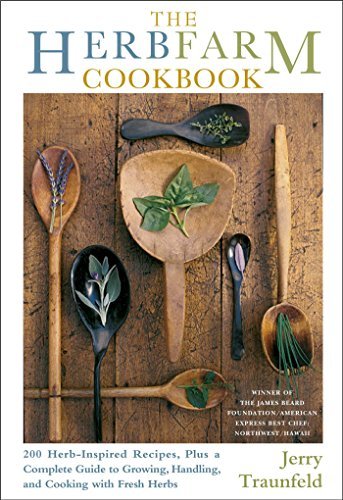
The Herbfarm Cookbook
By Jerry Traunfeld
Like what you hear? Please share our podcast with a friend. Subscribe on iTunes or your favorite podcast player so you never miss a beat. And we'd really appreciate you showing us some love by leaving a rating and review on iTunes.
Have a topic you'd like see us dig in to? Leave us a note in the comment section below or #EBpodcast on Instagram and Twitter!
Your support is what keeps this podcast going! Any amount helps, so consider support us by making a one-time contribution:
Make a one time contribution
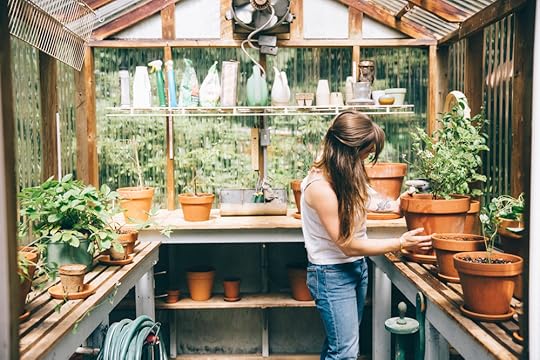
photo by charity burrgraaf
More about this weeks guest expert:
Shannon Douglas is the cook and photographer behind Honest Magazine, a quarterly publication focused on cooking, foraging, gardening and wildflowers, and the way these practices weave together to create an honest and connected life. In addition to the magazine, Shannon teaches classes on intuitive cooking and rustic crafts that bring us back into the wild and the wild back into us. She's a big believer in hammocks and is always on the lookout for new "weeds" to bring into the kitchen.
Website: https://www.honestquarterly.com/
Instagram: @honestmag

About the Host:
Hello, I’m Hilary Dahl. Outside of this podcast, my job is to help beginning and experienced growers create beautiful and productive gardens. I have the unique experience of working in on a wide range of projects, from small backyard garden plots to multi-acre vegetable farms. I also work in my own garden every day when I get home. This podcast is an opportunity to discuss seasonal garden topics and share the the joy of growing your own food.
Encyclopedia Botanica Podcast, Episode 90: Intuitive Cooking with Shannon Douglas, Spring Crop Edition

Shannon Douglas of Honest Magazine defines "cooking intuitively" is a style of cooking based on understanding the fundamentals of cooking and paying close attention to your ingredients. In this episode she joins Hilary to discuss some general garden-inspired cooking tips that you can apply to a variety of crops. They'll focus on 2 spring crops, peas and radishes, to help illustrate these points. As always, Hilary will sprinkle in her harvesting and gardening tips as they relate to cooking intuitively.
HOW TO LISTEN:Subscribe in iTunes , Stitcher, or any of your favorite podcast players to have new episodes sent directly to your device.Listen right now in your browser by clicking above.REsources Mentioned in this episode:
Six Seasons: A New Way with Vegetables
By Joshua McFadden

Salt, Fat, Acid, Heat: Mastering the Elements of Good Cooking
By Samin Nosrat

Portland Farmers Market Cookbook: 100 Seasonal Recipes and Stories that Celebrate Local Food and People
By Ellen Jackson

The Herbfarm Cookbook
By Jerry Traunfeld
Like what you hear? Please share our podcast with a friend. Subscribe on iTunes or your favorite podcast player so you never miss a beat. And we'd really appreciate you showing us some love by leaving a rating and review on iTunes.
Have a topic you'd like see us dig in to? Leave us a note in the comment section below or #EBpodcast on Instagram and Twitter!
We need your support to keep this podcast going! Any amount helps, so consider support us one of two ways:
Become an Encyclopedia Botanica Patreon
OR
Make a One-Time Contribution

photo by charity burrgraaf
More about this weeks guest expert:
Shannon Douglas is the cook and photographer behind Honest Magazine, a quarterly publication focused on cooking, foraging, gardening and wildflowers, and the way these practices weave together to create an honest and connected life. In addition to the magazine, Shannon teaches classes on intuitive cooking and rustic crafts that bring us back into the wild and the wild back into us. She's a big believer in hammocks and is always on the lookout for new "weeds" to bring into the kitchen.
Website: https://www.honestquarterly.com/
Instagram: @honestmag

About the Host:
Hello, I’m Hilary Dahl. Outside of this podcast, my job is to help beginning and experienced growers create beautiful and productive gardens. I have the unique experience of working in on a wide range of projects, from small backyard garden plots to multi-acre vegetable farms. I also work in my own garden every day when I get home. This podcast is an opportunity to discuss seasonal garden topics and share the the joy of growing your own food.
May 18, 2018
Episode 89: Cauliflower

We're talking cauliflower! This crop is notoriously difficult to grow compared to other plants in the Brassica oleracea family. In this episode we discuss why and steps you can take to maximize your cauliflower growing success.
HOW TO LISTEN:Subscribe in iTunes , Stitcher, or any of your favorite podcast players to have new episodes sent directly to your device.
Listen right now in your browser by clicking above.
SHOW NOTES:Cauliflower is an annual crop in the Brassica oleracea family. We talk about this plant family a lot because it contains many popular home-grown vegetables including Broccoli, cabbage and kale. These are all what we classify as half-season crops, which mean that they take roughly 1/2 a season to mature. Depending on where you're growing and how you're planting your space, often times you can plant two or more successions of these crops per growing season.
Cauliflower heads resemble that of a broccoli head, but they are actually different parts of the plant. A broccoli head is the immature flower and a cauliflower head is the inflorescence meristem.
Cauliflower thrive when grown in the cooler part of the season. Temperatures ranging from 60-70 degrees F are ideal. Sharp spikes in air and soil temperatures can quickly stress out the plants.
Consistent watering is key! Consider installing a drip irrigation system on an automatic timer.
Be sure to fertilize your beds before planting, and then again at 3 and 6 weeks after planting.
Unlike broccoli, cauliflower will not send out side-shoots, so you'll want to pull the plant after harvesting to make room for something else!
Left to right: Harvesting cheddar cauliflower, Grafitti cauliflower, a giant Snow Crow and normal Cheddar cauliflower.
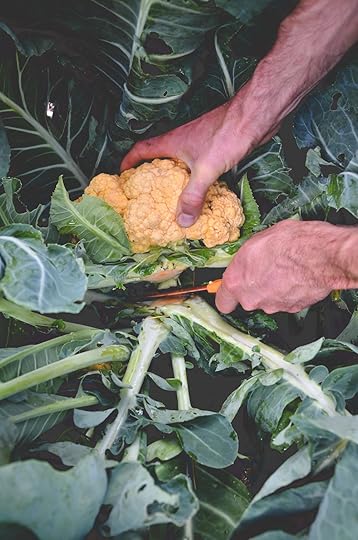

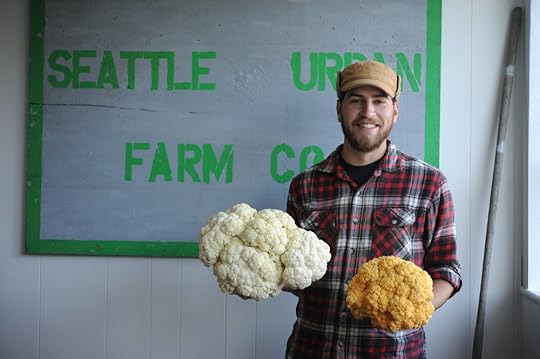
Books By Colin McCrate:
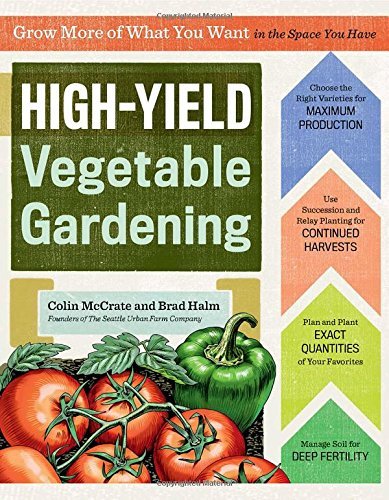
By Colin McCrate, Brad Halm
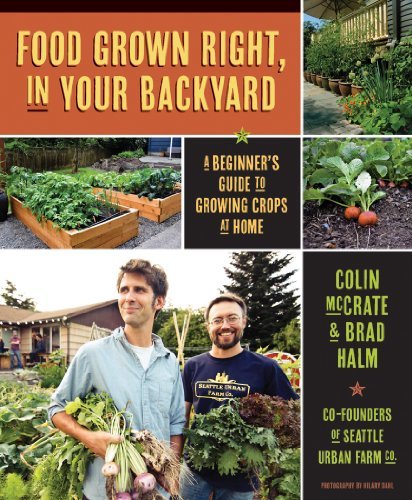
By Colin McCrate, Brad Halm
Like what you hear? Please share our podcast with a friend. Subscribe on iTunes or your favorite podcast player so you never miss a beat. And we'd really appreciate you showing us some love by leaving a rating and review on iTunes.
Have a topic you'd like see us dig in to? Leave us a note in the comment section below or #EBpodcast on Instagram and Twitter!
Your support is what keeps this podcast going! Any amount helps, so consider support us by making a one-time contribution:
Make a one time contribution

More about this weeks guest expert:
Colin McCrate is the founder of the Seattle Urban Farm Co. He has been growing food organically for over 15 years and has designed and has managed projects ranging from multi-acre farms to small backyard gardens. The author of two books; Food Grown Right, In Your Backyard (Mountaineers Books, 2012) and The High-Yield Garden Planner (Storey Publishing, 2015); he believes that urban food production can help increase public awareness of environmental, health, and social issues.
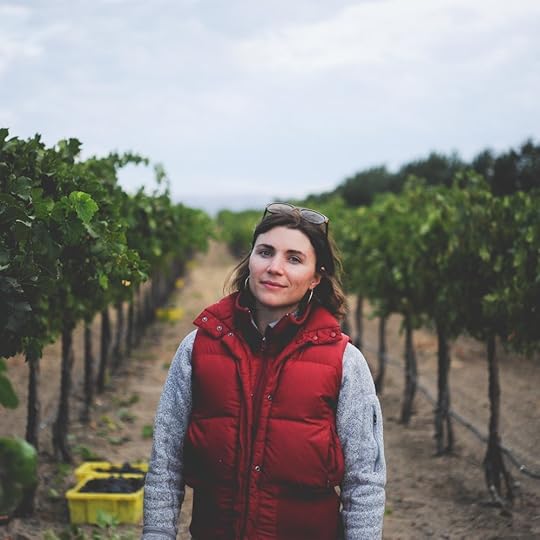
About the Host:
Hello, I’m Hilary Dahl. Outside of this podcast, my job is to help beginning and experienced growers create beautiful and productive gardens. I have the unique experience of working in on a wide range of projects, from small backyard garden plots to multi-acre vegetable farms. I also work in my own garden every day when I get home. This podcast is an opportunity to discuss seasonal garden topics and share the the joy of growing your own food.
Encyclopedia Botanica Podcast, Episode 89: Cauliflower

We're talking cauliflower! This crop is notoriously difficult to grow compared to other plants in the Brassica oleracea family. In this episode we discuss why and steps you can take to maximize your cauliflower growing success.
HOW TO LISTEN:Subscribe in iTunes , Stitcher, or any of your favorite podcast players to have new episodes sent directly to your device.Listen right now in your browser by clicking above.SHOW NOTES:Cauliflower is an annual crop in the Brassica oleracea family. We talk about this plant family a lot because it contains many popular home-grown vegetables including Broccoli, cabbage and kale. These are all what we classify as half-season crops, which mean that they take roughly 1/2 a season to mature. Depending on where you're growing and how you're planting your space, often times you can plant two or more successions of these crops per growing season. Cauliflower heads resemble that of a broccoli head, but they are actually different parts of the plant. A broccoli head is the immature flower and a cauliflower head is the inflorescence meristem.Cauliflower thrive when grown in the cooler part of the season. Temperatures ranging from 60-70 degrees F are ideal. Sharp spikes in air and soil temperatures can quickly stress out the plants.Consistent watering is key! Consider installing a drip irrigation system on an automatic timer.Be sure to fertilize your beds before planting, and then again at 3 and 6 weeks after planting.Unlike broccoli, cauliflower will not send out side-shoots, so you'll want to pull the plant after harvesting to make room for something else!Left to right: Harvesting cheddar cauliflower, Grafitti cauliflower, a giant Snow Crow and normal Cheddar cauliflower.
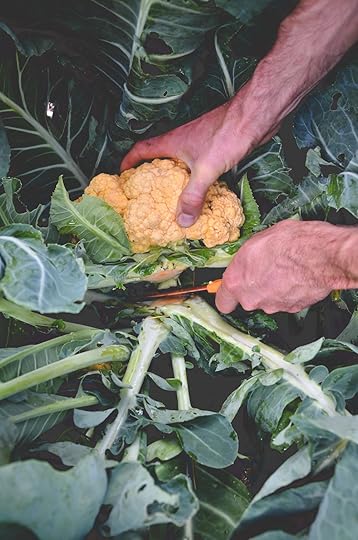


Books By Colin McCrate:

By Colin McCrate, Brad Halm

By Colin McCrate, Brad Halm
Like what you hear? Please share our podcast with a friend. Subscribe on iTunes or your favorite podcast player so you never miss a beat. And we'd really appreciate you showing us some love by leaving a rating and review on iTunes.
Have a topic you'd like see us dig in to? Leave us a note in the comment section below or #EBpodcast on Instagram and Twitter!
We need your support to keep this podcast going! Any amount helps, so consider support us one of two ways:
Become an Encyclopedia Botanica Patreon
OR
Make a one-time contribution to the EB podcast

More about this weeks guest expert:
Colin McCrate is the founder of the Seattle Urban Farm Co. He has been growing food organically for over 15 years and has designed and has managed projects ranging from multi-acre farms to small backyard gardens. The author of two books; Food Grown Right, In Your Backyard (Mountaineers Books, 2012) and The High-Yield Garden Planner (Storey Publishing, 2015); he believes that urban food production can help increase public awareness of environmental, health, and social issues.

About the Host:
Hello, I’m Hilary Dahl. Outside of this podcast, my job is to help beginning and experienced growers create beautiful and productive gardens. I have the unique experience of working in on a wide range of projects, from small backyard garden plots to multi-acre vegetable farms. I also work in my own garden every day when I get home. This podcast is an opportunity to discuss seasonal garden topics and share the the joy of growing your own food.
May 5, 2018
Episode 88: Backyard Honeybee Habitat with Mace Vaughn of The Xerces Society

Backyard beekeeping of honeybees is a great way to increase the number of pollinators in your garden, learn about how pollination works and, of course, the hives provide you with your own source of local honey. One thing that is not commonly discussed is that honeybees are not native to North America. While honeybees are very beneficial, there are also many species of native bees that could use help too. Today we are going to talk a bit about native bees and why its important to create habitat for native pollinators, especially if you're a backyard honeybee keeper.
HOW TO LISTEN:Subscribe in iTunes , Stitcher, or any of your favorite podcast players to have new episodes sent directly to your device.
Listen right now in your browser by clicking above.
SHOW NOTES:Backyard beekeeping of honeybees is a great way to increase the number of pollinators in your garden, learn about how pollination works and, of course, the hives provide you with your own source of local honey. One thing that is not commonly discussed is that honeybees are not native to North America. While honeybees are very beneficial, there are around 3,600 different species of native bees that could use help too.
Originating from Europe and Asia, the honeybee is not native to North America.
Honeybees are not able to pollinate all flowers. For example, honeybees do not pollinate tomatoes because they cannot get the pollen from the flowers and because the flowers do not produce nectar. Many native bees, however, know the trick to extracting tomato pollen and are, therefore, valuable pollinators.
Honeybees live in large colonies and are heavy feeders. If you introduce them into your garden or farm, they'll compete for resources with the native bee populations. If the resources are limited, the honeybees could end up pushing out your native bees, so it's important to add additional pollinator habitat if you're keeping honeybees in your backyard.
Below: Ground nesting bee or a "Tickle bee"

Photo by Mace Vaughn
Excellent books by The Xerces Society:
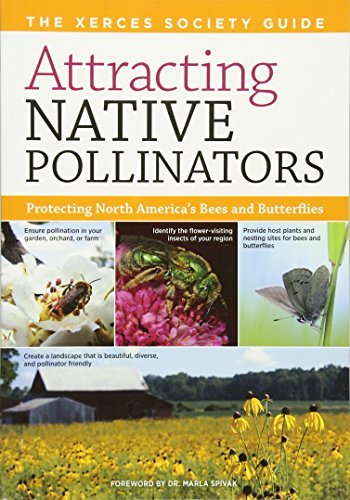
Attracting Native Pollinators: The Xerces Society Guide, Protecting North America's Bees and Butterflies
By The Xerces Society
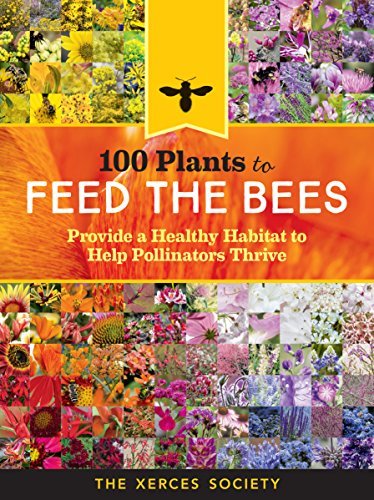
100 Plants to Feed the Bees: Provide a Healthy Habitat to Help Pollinators Thrive
By The Xerces Society

Farming with Native Beneficial Insects: Ecological Pest Control Solutions by Xerces Society, The (2014) Paperback
Storey Publishing, LLC
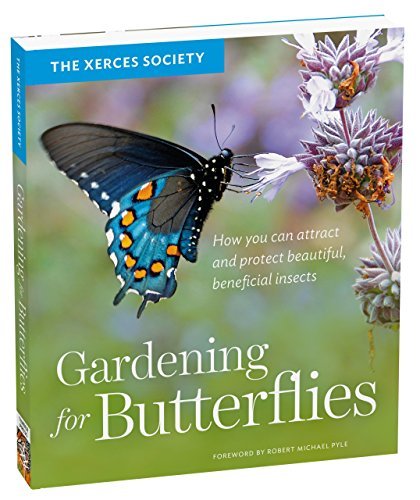
Gardening for Butterflies: How You Can Attract and Protect Beautiful, Beneficial Insects
By The Xerces Society
Like what you hear? Please share our podcast with a friend. Subscribe on iTunes or your favorite podcast player so you never miss a beat. And we'd really appreciate you showing us some love by leaving a rating and review on iTunes.
Have a topic you'd like see us dig in to? Leave us a note in the comment section below or #EBpodcast on Instagram and Twitter!
Your support is what keeps this podcast going! Any amount helps, so consider support us by making a one-time contribution:
Make a one time contribution

More about our Guest Expert:
Mace Vaughan serves as The Xerces Society’s Pollinator Conservation Program Co-Director and also as a partner biologist and Pollinator Conservation Specialist with the USDA NRCS West National Technology Support Center in Portland, Oregon. Mace has led Xerces’ Pollinator Conservation Program since 2003. During his tenure at the Xerces Society, the pollinator program has grown from a small pilot project on California farms to a national, multi-million dollar program, implementing pollinator conservation projects across the US. Helping to oversee a team of twenty-four pollinator conservation specialists and several consultants across the U.S., Mace now helps to manage the largest pollinator conservation team in the country.
Mace has written numerous articles on the conservation of beneficial insects, and is co-author of several books, including Attracting Native Pollinators: Protecting North America’s Bees and Butterflies and Farming with Native Beneficial Insects. He was a lecturer on honey bee biology and beekeeping at Cornell University, from which he holds Degrees in Entomology, Natural Resource Management, and Teaching.
Website: xerces.org
Instagram: @xercessociety
Facebook: @xercessociety

About the Host:
Hello, I’m Hilary Dahl. Outside of this podcast, my job is to help beginning and experienced growers create beautiful and productive gardens. I have the unique experience of working in on a wide range of projects, from small backyard garden plots to multi-acre vegetable farms. I also work in my own garden every day when I get home. This podcast is an opportunity to discuss seasonal garden topics and share the the joy of growing your own food.
Encyclopedia Botanica Podcast, Episode 88: Backyard Honeybee Habitat with Mace Vaughn of The Xerces Society

Backyard beekeeping of honeybees is a great way to increase the number of pollinators in your garden, learn about how pollination works and, of course, the hives provide you with your own source of local honey. One thing that is not commonly discussed is that honeybees are not native to North America. While honeybees are very beneficial, there are also many species of native bees that could use help too. Today we are going to talk a bit about native bees and why its important to create habitat for native pollinators, especially if you're a backyard honeybee keeper.
HOW TO LISTEN:Subscribe in iTunes , Stitcher, or any of your favorite podcast players to have new episodes sent directly to your device.Listen right now in your browser by clicking above.SHOW NOTES:Backyard beekeeping of honeybees is a great way to increase the number of pollinators in your garden, learn about how pollination works and, of course, the hives provide you with your own source of local honey. One thing that is not commonly discussed is that honeybees are not native to North America. While honeybees are very beneficial, there are around 3,600 different species of native bees that could use help too. Originating from Europe and Asia, the honeybee is not native to North America.Honeybees are not able to pollinate all flowers. For example, honeybees do not pollinate tomatoes because they cannot get the pollen from the flowers and because the flowers do not produce nectar. Many native bees, however, know the trick to extracting tomato pollen and are, therefore, valuable pollinators.Honeybees live in large colonies and are heavy feeders. If you introduce them into your garden or farm, they'll compete for resources with the native bee populations. If the resources are limited, the honeybees could end up pushing out your native bees, so it's important to add additional pollinator habitat if you're keeping honeybees in your backyard.Below: Ground nesting bee or a "Tickle bee"

Photo by Mace Vaughn
Excellent books by The Xerces Society:

Attracting Native Pollinators: The Xerces Society Guide, Protecting North America's Bees and Butterflies
By The Xerces Society

100 Plants to Feed the Bees: Provide a Healthy Habitat to Help Pollinators Thrive
By The Xerces Society

Farming with Native Beneficial Insects: Ecological Pest Control Solutions by Xerces Society, The (2014) Paperback
Storey Publishing, LLC

Gardening for Butterflies: How You Can Attract and Protect Beautiful, Beneficial Insects
By The Xerces Society
Like what you hear? Please share our podcast with a friend. Subscribe on iTunes or your favorite podcast player so you never miss a beat. And we'd really appreciate you showing us some love by leaving a rating and review on iTunes.
Have a topic you'd like see us dig in to? Leave us a note in the comment section below or #EBpodcast on Instagram and Twitter!
We need your support to keep this podcast going! Any amount helps, so consider support us one of two ways:
Become an Encyclopedia Botanica Patreon
OR
Make a one-time contribution to the EB podcast

More about our Guest Expert:
Mace Vaughan serves as The Xerces Society’s Pollinator Conservation Program Co-Director and also as a partner biologist and Pollinator Conservation Specialist with the USDA NRCS West National Technology Support Center in Portland, Oregon. Mace has led Xerces’ Pollinator Conservation Program since 2003. During his tenure at the Xerces Society, the pollinator program has grown from a small pilot project on California farms to a national, multi-million dollar program, implementing pollinator conservation projects across the US. Helping to oversee a team of twenty-four pollinator conservation specialists and several consultants across the U.S., Mace now helps to manage the largest pollinator conservation team in the country.
Mace has written numerous articles on the conservation of beneficial insects, and is co-author of several books, including Attracting Native Pollinators: Protecting North America’s Bees and Butterflies and Farming with Native Beneficial Insects. He was a lecturer on honey bee biology and beekeeping at Cornell University, from which he holds Degrees in Entomology, Natural Resource Management, and Teaching.
Website: xerces.org
Instagram: @xercessociety
Facebook: @xercessociety

About the Host:
Hello, I’m Hilary Dahl. Outside of this podcast, my job is to help beginning and experienced growers create beautiful and productive gardens. I have the unique experience of working in on a wide range of projects, from small backyard garden plots to multi-acre vegetable farms. I also work in my own garden every day when I get home. This podcast is an opportunity to discuss seasonal garden topics and share the the joy of growing your own food.



